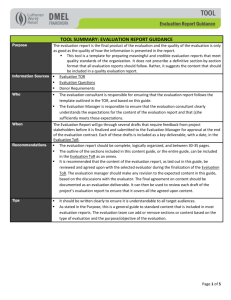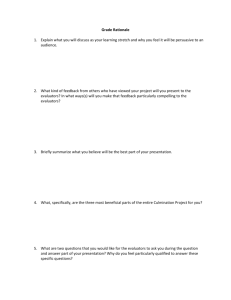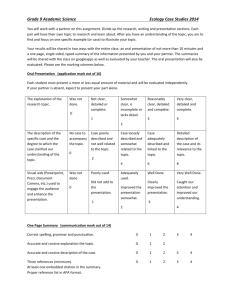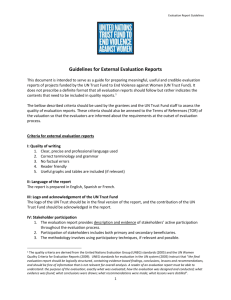Purpose/Description of the Evaluation Report
advertisement
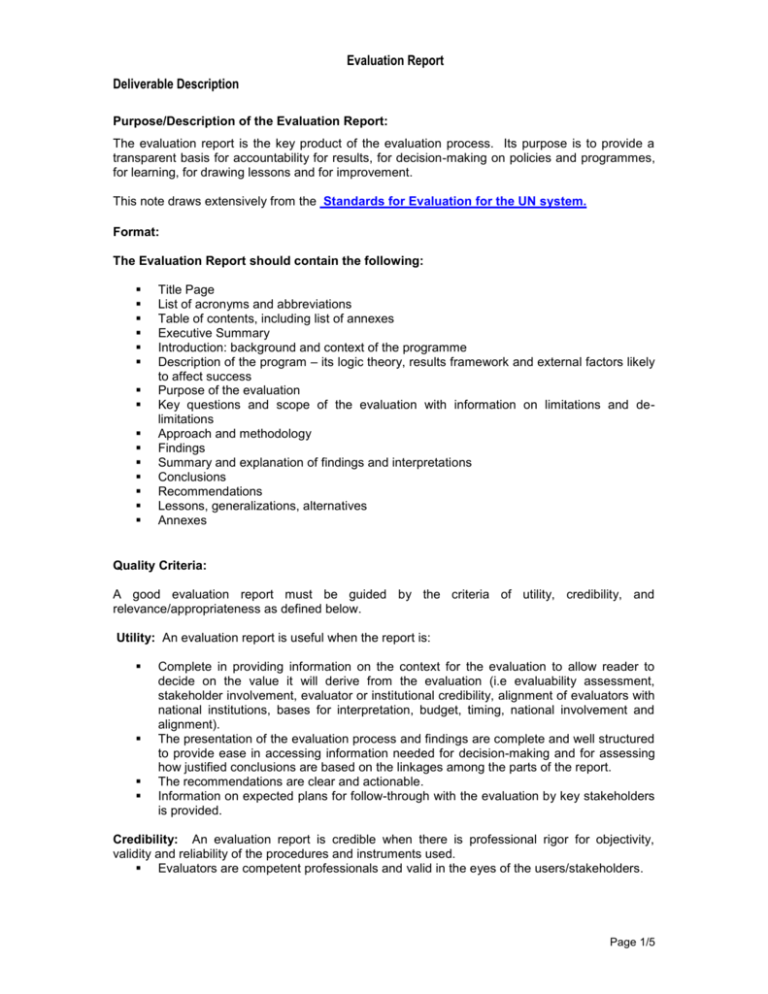
Evaluation Report Deliverable Description Purpose/Description of the Evaluation Report: The evaluation report is the key product of the evaluation process. Its purpose is to provide a transparent basis for accountability for results, for decision-making on policies and programmes, for learning, for drawing lessons and for improvement. This note draws extensively from the Standards for Evaluation for the UN system. Format: The Evaluation Report should contain the following: Title Page List of acronyms and abbreviations Table of contents, including list of annexes Executive Summary Introduction: background and context of the programme Description of the program – its logic theory, results framework and external factors likely to affect success Purpose of the evaluation Key questions and scope of the evaluation with information on limitations and delimitations Approach and methodology Findings Summary and explanation of findings and interpretations Conclusions Recommendations Lessons, generalizations, alternatives Annexes Quality Criteria: A good evaluation report must be guided by the criteria of utility, credibility, and relevance/appropriateness as defined below. Utility: An evaluation report is useful when the report is: Complete in providing information on the context for the evaluation to allow reader to decide on the value it will derive from the evaluation (i.e evaluability assessment, stakeholder involvement, evaluator or institutional credibility, alignment of evaluators with national institutions, bases for interpretation, budget, timing, national involvement and alignment). The presentation of the evaluation process and findings are complete and well structured to provide ease in accessing information needed for decision-making and for assessing how justified conclusions are based on the linkages among the parts of the report. The recommendations are clear and actionable. Information on expected plans for follow-through with the evaluation by key stakeholders is provided. Credibility: An evaluation report is credible when there is professional rigor for objectivity, validity and reliability of the procedures and instruments used. Evaluators are competent professionals and valid in the eyes of the users/stakeholders. Page 1/5 Evaluation Report Deliverable Description There is accuracy and validity (programme content and contextual factors, instruments, information coverage/sampling, external validity or linkage with other development findings). There is reliability or consistency in the information provided. The bases for making judgements are transparent and based on negotiated agreements. Relevance, appropriateness and added-value: A report is relevant, appropriate and adds value when information provided addresses priority or strategic information needs, is not duplicative, and is appropriate given institutional goals. The conduct of evaluation is aligned with national systems. The purpose and incentives for use are clear. There is alignment with national and government demands, harmonization and coherence within UN and organizational lens: human development and human rights. Addresses organizational mandate and the Strategic Plan priorities. Advances knowledge or priorities for development (equity, capacity, cooperation and others). The following provides for each criterion, performance indicators which would provide the basis for assessing report quality in an objective and reliable manner. 1. Utility – Enhancing use and impact of information provided 1.1 The title page and opening pages provide key basic contextual information Title of the evaluation that includes a clear reference to the project / programme being evaluated. Links to the evaluation plan (with information on strategic value, national involvement and alignment, timing, resources and financing). Links to UNDAF outcomes and the Strategic Plan priorities. Geographical coverage of the evaluation. Name and organization of the evaluators and information in annex for assessment of competence and trustworthiness. Name of the commissioning organization (e.g. UNDP country office X). Date when the evaluation report is completed. Expected actions from the evaluation and dates for action. Dates for stakeholder meetings and status of meetings. Name of UNDP contact point for the evaluation (e.g. evaluation task manager). 1.2 For a joint evaluation or for the evaluation of a joint programme, the roles and contributions of the different UN organizations or other partners, are clearly described. The report should describe who is involved, their roles and their contributions to the subject being evaluated, including: Financial and in-kind contributions such as technical assistance, training and logistic support. Participation and staff time. Leadership, advocacy and lobbying. 1.3 For a country-led joint evaluation, the framework for the leadership, governance, conduct, use and capacity development are clearly described, and norms and standards for the evaluation are delineated if necessary. 1.4 The information in the report is complete, well structured and well presented. The report should provide information on: Page 2/5 Evaluation Report Deliverable Description The purpose of the evaluation. Exactly what was evaluated. How the evaluation was designed and conducted. What evidence was used in the evaluation. What conclusions were drawn. What recommendations were made. What lessons were distilled. 1.5 The report should be clear and easy to read with complementary graphics to enhance understanding: The report should apply a plain, non-specialist language. Graphics, tables and illustrations should be used, when applicable, to enhance the presentation of information. The report should not exceed 50 pages, excluding annexes. In the case of an outcome evaluation, the related projects should be listed in the annex, including timelines, implementation arrangements and budgets. 1.6 The executive summary of the report should be brief (maximum 2-3 pages) and contains key information needed by decision-makers. It should contain: Brief description of the programme. Evaluation purpose, questions and scope of evaluation. Key findings. Conclusions. Key recommendations. The executive summary should not include information that is not mentioned and substantiated in the main report. 1.7 The recommendations are relevant and realistic, with clear priorities for action. Recommendations should emerge logically from the evaluation’s findings and conclusions. Recommendations should be relevant to the purpose of the evaluation and decisions to be made based on the evaluation. Recommendation should be formulated in a clear and concise manner and be prioritized to the extent possible. 2. Credibility - accuracy, reliability, and objectivity 2.1. The subject or programme being evaluated is clearly and accurately described. The goals and objectives of the programme/project/subject are clearly described and the performance indicators presented. The conceptual linkages or logic theory among programme/project strategy, the outputs and the outcomes should be described, explaining their relation to national priorities and goals. The context in which the programme/project existed is described so its likely influences in the program can be identified. The level of implementation of the programme/project and major divergences between the original implementation plan or approach should be described and explained. The recipient /intended beneficiaries, the stake holders, the cost and the financing of the programmes/projects should be described. Page 3/5 Evaluation Report Deliverable Description 2.2. The report provides a clear explanation of the scope of the evaluation. The objectives, scope and coverage of the evaluation should be explicit and its limitations should also be acknowledged. The original evaluation questions from the TORs should be made explicit as well as those that were added subsequently or during the evaluation and their rationale provided. The results of an evaluability assessment are noted for its effects on defining the scope of the evaluation. Evaluability is the extent to which there is clarity in the intent of the subject to be evaluated, sufficient measurable indicators, assessable reliable information sources and no major factor hindering an impartial evaluation process 1. 2.3. The methodology is fully described for its role in ensuring the validity and reliability of the evaluation. Any description of the methodology should include the following in addressing the questions of the evaluation: The universe of data needed to answer the questions and the sources of this data. The sampling procedure applied to ensure representativeness in collecting information from these sources (area and population to be represented, rationale for selection, mechanics of selection, numbers selected out of potential subjects, limitations to sampling). Procedures applied (including triangulation) to ensure the accuracy and reliability of the information collected. Bases for making judgements and interpretation of the findings including performance indicators or levels of statistical significance as warranted by available data. Description of procedures for quantitative and qualitative analyses. Innovations in methodological approach and added value to development evaluation. How the evaluation addressed equity in its design and in the provision of differentiated information to guide policies and programmes. How a human development and human rights perspective provided a lens for the evaluation and influenced the scope of the evaluation. 2.4. The findings of the evaluation address the following in response to the key questions of the evaluation. Cost efficiency and relevance. UNDP partnership strategy and the extent to which it contributed to greater effectiveness. External factors influencing progress towards the outcome. UNDP contribution to capacity development and institutional strengthening. 2.5 Conclusions are firmly based on evidence and analysis. Conclusions are the judgement made by the evaluators. They should not repeat the findings but address the key issues that can be abstracted from them. Conclusions are made based on an agreed basis for making judgments of value or worth relative to relevance, effectiveness, efficiency, sustainability. Conclusions must focus on issues of significance to the subject being evaluated, determined by the evaluation objectives and the key evaluation questions. 2.5. Annexes are complete and relevant. 1 The original Terms of Reference for the evaluation. Norms for Evaluation for the United Nations System, para 7.2. Page 4/5 Evaluation Report Deliverable Description Details on the programme and its context in development. Details of data and analyses. Data collection instruments (e.g. copies of questionnaires, and surveys). Evaluation plan. Relevance and Added Value 3.1. The purpose and context of the evaluation are described. The reason(s) why the evaluation is being conducted should be explicitly stated. The justification for conducting the evaluation at this point in time should be summarised. Who requires the evaluative information should be made clear. The description of context should provide an understanding of the geographic, socioeconomic, political and cultural settings in which the evaluation took place. 3.2. The report includes an assessment of the extent to which issues of equity and gender, in particular, and human rights considerations are incorporated in the project or programme. The evaluation report should include a description of, inter alia: How a human development and human rights perspective was adopted in design, implementation and monitoring of the projects or programme being evaluated. How issues of equity, marginalized, vulnerable and hard-to-reach groups were addressed in design, implementation and monitoring of the projects or programme being evaluated. How the evaluation addressed equity in its design and in the provision of differentiated information to guide policies and programmes. How the evaluation used the human development and human rights lens in its defining the scope of the evaluation and in the methodology used. 3.3 The report presents information on its relationship with other associated evaluations and indicates its added value to already existing information. Procedures and Accountabilities: The primary responsibility for preparing the evaluation report rests with the evaluation consultant or the leader of the evaluation team (if a team is established). Those who commission the evaluation and those who are actually evaluated can also contribute with their inputs. Particularly, key stakeholders should be involved in reviewing the draft report to check if there are any relevant factual errors or omissions, and to highlight any interpretation of the findings that they consider as incorrect. The evaluators should accept changes related to factual errors, but in safeguarding the principle of independence, they should be free to draw their own conclusions from the findings. To ensure compliance with the criteria noted, a quality assurance and enhancement system at country level (e.g. a panel comprised of members of the outcome/project board and Programme Manager or designate) should be established and made operational. Where appropriate, a panel of evaluation experts can be established to play an advisory role with a view to enhancing the overall quality of the report. Page 5/5
